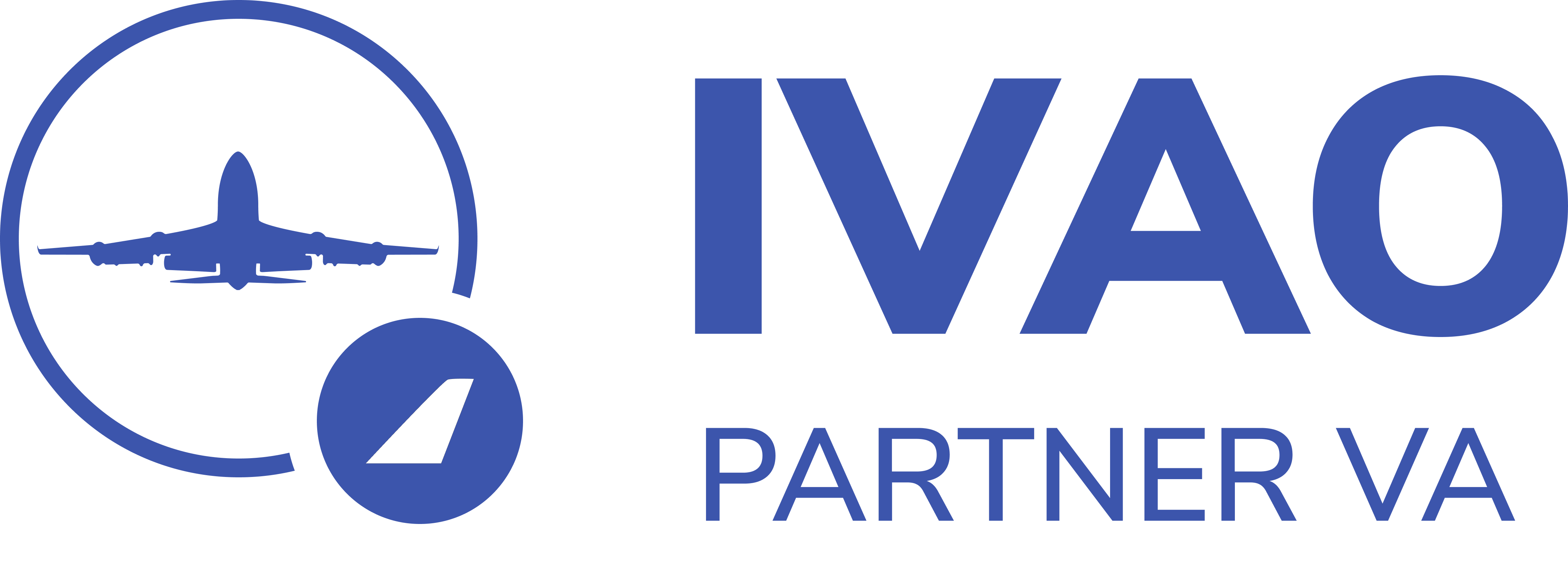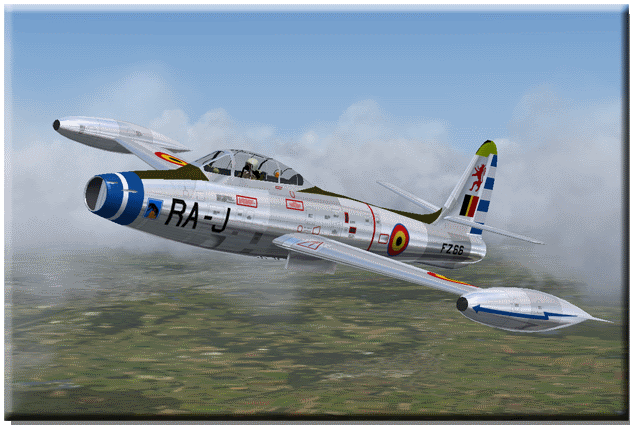Vickers Supermarine Spitfire

Spitfire XVI of the 350th Squadron
in action over occupied Europe.
The Vickers Supermarine Spitfire is flown for the first time by Belgian pilots at the start of the Second World War. Belgian pilots and prospective pilots are coming in from everywhere. North and South America, Africa and even China. Most of them originate from Belgium of course after a brief period in POW camps in France, Portugal or Spain. Most of them are recruited by the Royal Air Force and dispersed to different bomber and fighter squadrons. February 11, 1941 a Belgian Flight is established within the 609th Squadron. After only one year their numbers grow so large the R.A.F. decides to establish a full Belgian squadron. February 11, 1942 the 350th Squadron is established and given the squadron code MN. November the same year a second squadron joins the ranks, the 349th Squadron, code GE. Both squadrons are equipped with Spitfire Mk.IIA of the R.A.F
The rich Belgian colonies in Africa are pitching in and raise enough cash to buy 12 Spitfires Mk.V for the 350th Squadron.
Later both squadrons receive the Spitfire Mk.IX from the Royal Air Force.
Towards the end of the war they are equipped with Spitfire LF16E and are eventually stationed in occupied Germany at Fassburg. In 1946 the British markings are painted over with Belgian colors.
After establishing the Belgian Air Force in 1948 these Spitfires return to Belgium on loan from the R.A.F. The Belgian government decides to buy a number of Spitfires to equip the new Wings and Squadrons. The Spitfire XVI is equiped with an American licence-build Packard-Bell engine. This proves to be a problem when delivered to third parties. The British Government offers to deliver the more powerfull Griffon 65 equiped Spitfire XIV. Eventually, 132 Spitfire F14C, F14E en FR14E (codes SG1-SG132) are acquired to equip the fighter squadron. In addition to this, 28 Spitfire IX (codes SM1-SM28) are purchased for the flying school. Due to a high attrition rate it becomes necessary to order some additional aircraft. An order for 15 secondhand Spitfires IX is signed with the LSK/Fokker in the Netherlands (codes SM29-SM43). These machines were formerly used in the Dutch-Indies.
Together with the 24 Spitfire LF16E, the Belgian Air Force owned almost 200 Spitfires. A year later, the borrowed LF16E's are returned to the R.A.F. The Spitfire remains in service with the Belgian Air Force until 1952 when the 10th Wing receives its first F-84E Thunderjet.
Technical Specifications
| Span | 10,19 m |
| Length | 10,08 m |
| Height | 3,91 m |
| Engine | Rolls-Royce Griffon 65 at 2035 Hp |
| Maximum speed | 706 Km/u - 381 Kts |
| Ceiling | 13.115 m - 39.345 ft |
| Weight | 1.367 km - 738 Nm |
| Gewicht | 3.946 kg - 8700 Lbs |
| Armament | Two 20 mm Hispano Mk2 canons. Two .50 Browning machine guns (12,7mm) Two attachment points under wing for bombs or fuel tanks. |
Vickers-Supermarine Spitfire F14C/F14E/FR14E
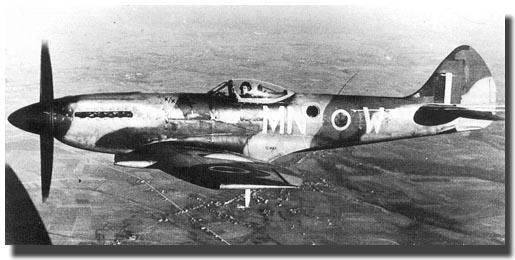
Spitfire FR.XIV E, 350th Squadron, 1st Fighter Wing
Color scheme's
The first Spitfires Mk.I are painted in the pre-war brown/green camouflage pattern like all contemporary British aircraft. Starting with the Spitfire Mk.II the British adopt a new grey/green pattern. Exceptions not withstanding, like desert camouflage, all Spitfires are delivered in this outfit.
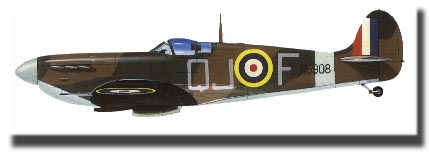
Spitfire Mk.I B, November 1940
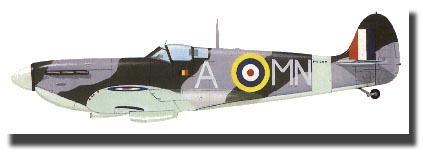
Spitfire Mk.II A, 350Sqn, November 1941
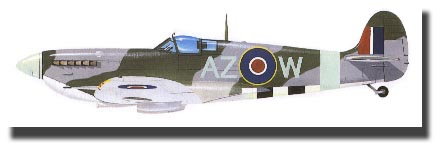
Spitfire Mk.V B, 234Sqn, May 1942

Spitfire Mk.IX E, 453Sqn RAAF, June 1944
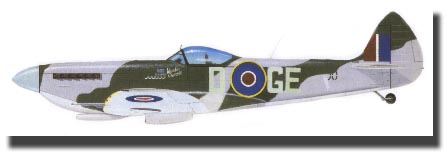
Spitfire Mk.XVI, 349Sqn, Fassburg 1945
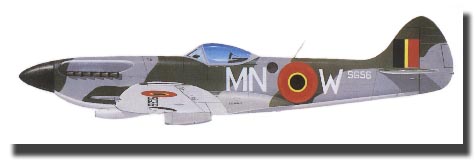
Spitfire FR XIV E, 350Sqn, late 1945
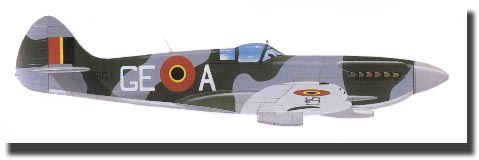
Spitfire F XIV E, 349Sqn, late 1945

Spitfire FR XIV E, 1st Squadron, 2nd Wing, 1947
After establishing the Belgian Air Force in 1948, most of the Spitfires are painted silver with a matt black anti glare panel in front of the cockpit. On Spitfires IX (SM-1 to SM-28) and all Spitfires XIV, the entire nose is provided with anti-glare black. On the former Dutch Spitfires IX (SM-29 to SM-43), only half of the nose is covered with anti-glare black.

Spitfire Mk.IX , OTU Brustem, 1949

Spitfire FR XIV E, Fighter School Koksijde, 1950
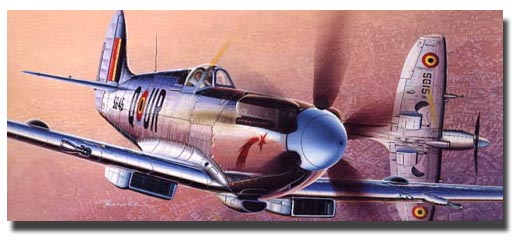
Spitfire F.Mk XIV E, 2nd Squadron, 2nd Fighter Wing
 NL
NL  EN
EN 
